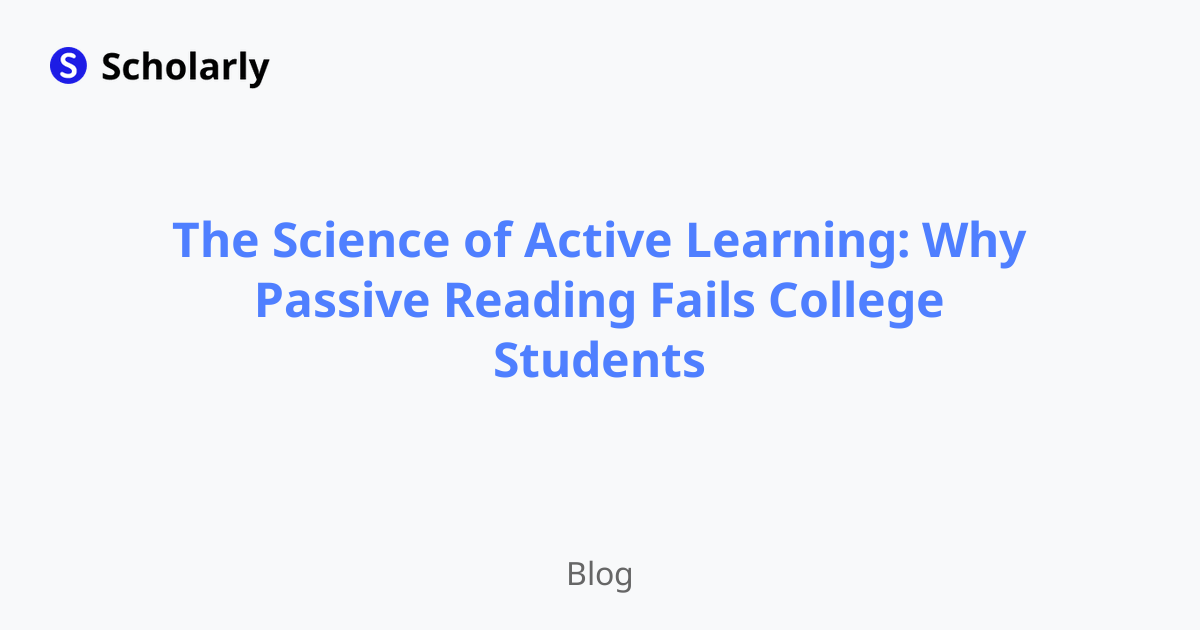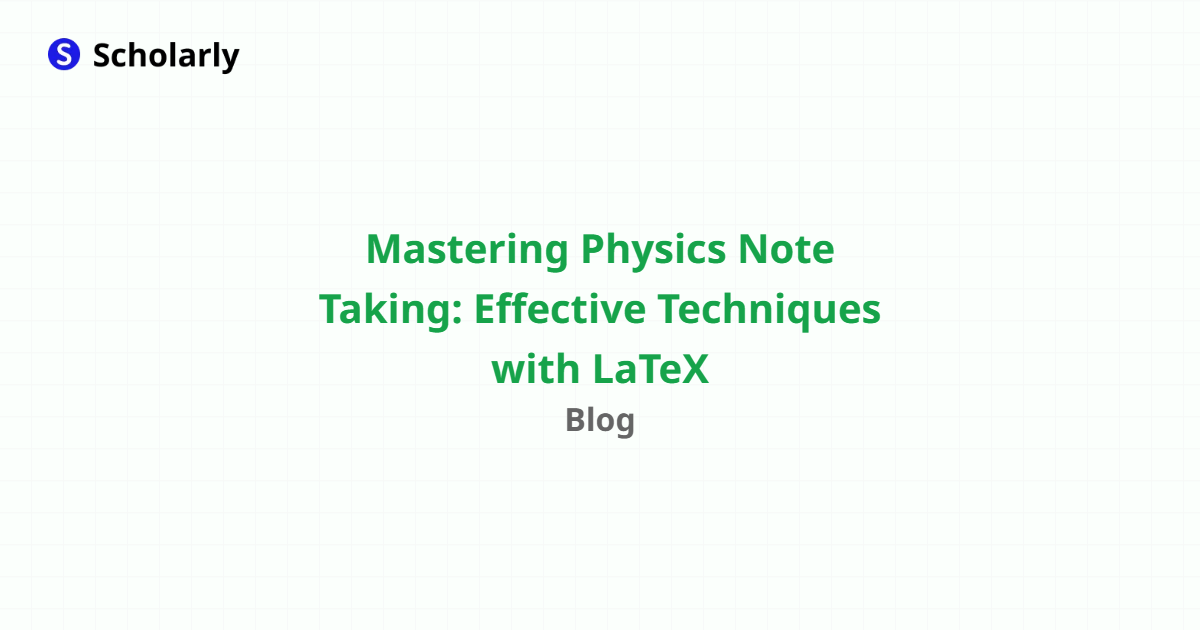The Science of Active Learning: Why Passive Reading Fails College Students
Discover why passive studying techniques fail and learn evidence-based active learning strategies that can double your retention and academic performance.

Introduction
If you're like most college students, you probably spend hours reading textbooks, highlighting important passages, and re-reading notes—yet still struggle to remember information when exam time arrives. This frustrating experience isn't due to lack of intelligence or effort; it's because passive learning methods are fundamentally ineffective for long-term retention. Recent neuroscience research has revolutionized our understanding of how the brain actually learns, revealing that active engagement with material is essential for forming lasting memories. This guide explores the scientific principles behind active learning and provides practical strategies to transform your study sessions from passive consumption to dynamic engagement.
History
The concept of active learning has ancient roots, with Socratic questioning dating back to 470 BC. However, modern educational research began seriously investigating learning methods in the early 20th century. Hermann Ebbinghaus's forgetting curve research in the 1880s first demonstrated the rapid decay of passively acquired information. The 1950s brought Edgar Dale's "Cone of Experience," showing that students retain only 10% of what they read but 90% of what they do. The 1990s marked a turning point when cognitive scientists like John Sweller developed Cognitive Load Theory, explaining why passive methods overwhelm working memory while active techniques enhance learning efficiency.
Current State
Today's educational landscape is gradually shifting toward active learning pedagogies, though many students still rely heavily on passive methods. Research consistently shows that students using active learning techniques score 6-15 points higher on exams than those using traditional passive approaches. However, surveys indicate that 70% of college students still primarily use passive methods like re-reading and highlighting. This disconnect exists partly because active learning requires more initial effort and feels less familiar than traditional studying approaches. The COVID-19 pandemic accelerated interest in active learning as educators sought more engaging online learning methods.
Future State
The future of education will likely be dominated by active learning approaches, supported by AI-powered adaptive systems that personalize learning experiences in real-time. Virtual and augmented reality technologies will create immersive learning environments where students can actively engage with complex concepts. Brain-computer interfaces may eventually provide direct feedback on learning effectiveness, optimizing study methods based on neural activity patterns. Gamification elements will continue expanding, making active learning more engaging and motivating for digital native students.
Benefits
- Dramatically Improved Retention: Active learning can increase long-term retention by 200-300% compared to passive methods
- Enhanced Critical Thinking: Active engagement develops analytical and problem-solving skills that passive reading cannot
- Better Exam Performance: Students using active techniques typically score 10-15% higher on assessments
- Increased Motivation and Engagement: Active methods make studying more interesting and personally meaningful
- Improved Metacognition: Active learners develop better awareness of their own learning processes and knowledge gaps
- Stronger Neural Connections: Active learning creates more robust neural pathways, leading to better knowledge transfer
Significance
Understanding the science of active learning is crucial for academic success in an increasingly competitive educational environment. The principles of active learning align with how the human brain naturally processes and stores information, making them universally applicable across subjects and learning contexts. Beyond academics, active learning skills translate directly to professional environments where continuous learning, problem-solving, and knowledge application are essential. Students who master active learning techniques often report feeling more confident, engaged, and in control of their educational experience.
Best Practices
- Test Yourself Frequently: Regular self-testing is one of the most powerful active learning techniques
- Explain Concepts Aloud: Teaching material to others or yourself forces active processing and reveals knowledge gaps
- Connect New Information to Prior Knowledge: Actively link new concepts to existing understanding
- Use Multiple Modalities: Engage visual, auditory, and kinesthetic learning channels simultaneously
- Practice Retrieval Without Notes: Force your brain to actively recall information rather than recognize it
- Ask Questions While Learning: Continuously generate questions about the material to maintain active engagement
Pros and Cons
Pros:
- Significantly superior retention and comprehension compared to passive methods
- Develops critical thinking and analytical skills essential for academic and professional success
- Creates more engaging and interesting study experiences
- Builds confidence through demonstrated mastery of material
- Improves problem-solving abilities and knowledge transfer
- Provides immediate feedback on learning progress and knowledge gaps
Cons:
- Requires more initial effort and cognitive energy than passive methods
- Can feel uncomfortable or difficult for students accustomed to passive approaches
- May take longer in the short term, though it's more efficient long-term
- Some students may resist active methods due to perceived increased difficulty
- Requires more planning and preparation than simple re-reading
- Can be challenging to implement in certain subjects or learning environments
Comparison
Different active learning approaches suit different learning preferences and subjects:
Retrieval Practice: Actively recalling information from memory without looking at notes. Most effective for factual information and concepts.
Elaborative Interrogation: Asking and answering "why" questions about material. Best for building conceptual understanding.
Self-Explanation: Explaining how new information relates to existing knowledge. Ideal for complex, interconnected subjects.
Interleaved Practice: Mixing different types of problems or concepts within study sessions. Excellent for mathematics and sciences.
Distributed Practice: Spacing study sessions over time rather than massing them together. Universal technique that enhances all other methods.
Methods
1. The Testing Effect Protocol
Replace re-reading with frequent self-testing. After reading a section, close your book and write down everything you can remember. Then check your accuracy and focus additional study on missed information. Research shows this method improves retention by up to 300% compared to re-reading the same material multiple times.
2. The Feynman Technique for Deep Understanding
Choose a concept and explain it in simple language as if teaching a child. If you struggle to explain something simply, it indicates incomplete understanding. Return to the source material, identify the confusion, and try explaining again. This technique forces active processing and reveals knowledge gaps that passive reading might miss.
3. Elaborative Interrogation Strategy
While studying, continuously ask yourself "why" and "how" questions: Why is this true? How does this connect to what I already know? How could I apply this principle? This questioning approach transforms passive consumption into active analysis and promotes deeper understanding.
4. Interleaved Practice Sessions
Instead of studying one topic for extended periods, mix different but related concepts within the same study session. For example, alternate between different types of math problems or historical periods. This approach initially feels more difficult but significantly improves learning transfer and retention.
5. The Generation Effect Technique
Before reading explanations, try to generate answers or solutions yourself. Even incorrect attempts prime your brain for learning and make subsequent information more memorable. This technique works for everything from vocabulary definitions to problem-solving strategies.
6. Spaced Retrieval Practice
Create a schedule for reviewing material at increasing intervals: review after 1 day, then 3 days, then 1 week, then 2 weeks. Each review session should focus on active recall rather than passive re-reading. This spacing schedule optimizes the forgetting curve for maximum retention.
7. Peer Teaching and Discussion
Regularly explain concepts to classmates or study group members. Teaching forces you to actively organize and articulate your understanding while exposing knowledge gaps. Listening to others' explanations provides alternative perspectives that deepen comprehension.
8. Problem-Based Learning Approach
Instead of studying theory first and then applying it, start with real problems and work backward to understand underlying principles. This approach mirrors how knowledge is actually used in professional contexts and creates more meaningful learning experiences.
AI Impact
Artificial intelligence is revolutionizing active learning through personalized adaptive systems that respond to individual learning patterns. AI tutors can generate unlimited practice questions, provide immediate feedback, and adjust difficulty levels based on performance. Machine learning algorithms analyze student responses to identify knowledge gaps and suggest targeted active learning activities.
Natural language processing enables AI systems to evaluate written explanations and provide feedback on conceptual understanding. Spaced repetition algorithms optimize review schedules based on individual forgetting curves. Virtual reality environments powered by AI create immersive active learning experiences that would be impossible in traditional settings.
Common Techniques
- Flashcard Testing: Using spaced repetition systems for active recall practice
- Mind Mapping: Creating visual representations that require active organization of information
- Problem Set Completion: Actively applying concepts through practice problems and exercises
- Concept Mapping: Drawing connections between different ideas and principles
- Case Study Analysis: Applying theoretical knowledge to real-world scenarios
- Peer Discussion Groups: Engaging in collaborative learning through explanation and debate
Challenges
- Initial Resistance: Students often resist active methods because they require more effort than familiar passive approaches
- Cognitive Load Management: Active learning can initially overwhelm students unaccustomed to deep processing
- Time Investment Perception: Active methods may seem slower initially, though they're more efficient long-term
- Confidence Issues: Active learning exposes knowledge gaps that passive methods might hide, affecting student confidence
- Implementation Difficulty: Knowing about active learning and successfully implementing it are different skills
- Subject-Specific Adaptation: Different subjects may require different active learning approaches
Potential Online Apps that Relate to the Topic
Scholarly: AI-powered platform that automatically generates active learning materials like flashcards and quizzes from your course content, implementing spaced repetition and retrieval practice.
Anki: Sophisticated spaced repetition flashcard system that optimizes review schedules based on your performance, perfect for implementing the testing effect.
Quizlet: Popular study platform offering various active learning modes including practice tests, matching games, and spaced repetition systems.
Remnote: Note-taking app that integrates spaced repetition flashcards directly into your notes, enabling seamless transition from passive reading to active testing.
Socratic by Google: AI-powered app that helps students work through problems step-by-step, promoting active problem-solving rather than passive answer-seeking.
Khan Academy: Educational platform built around active learning principles, featuring practice exercises, immediate feedback, and mastery-based progression.
Conclusion
The science is clear: passive learning methods like re-reading and highlighting are fundamentally ineffective for long-term retention and deep understanding. Active learning techniques, while requiring more initial effort, produce dramatically superior results in both academic performance and skill development. The key is understanding that learning is not something that happens to you—it's something you actively do.
Implementing active learning strategies requires a mindset shift from consuming information to engaging with it. Start small by incorporating one or two active techniques into your study routine, then gradually expand your toolkit as these methods become more natural. Remember that the initial discomfort you may feel is actually a sign that real learning is taking place.
The students who thrive in college and beyond are those who recognize that effective studying isn't about putting in more hours—it's about using methods that align with how the brain actually learns. By embracing active learning principles, you're not just improving your grades; you're developing the critical thinking, problem-solving, and continuous learning skills that will serve you throughout your career and life.
Try Our Popular AI Study Tools
Transform your study materials into interactive learning experiences with our most popular AI-powered tools:
PDF to Flashcards
Convert lecture notes and textbooks into study flashcards instantly
Text to Flashcards
Turn any text or notes into comprehensive flashcard sets
Image to Flashcards
Convert diagrams and handwritten notes into digital flashcards
YouTube to Flashcards
Generate flashcards from educational video content



